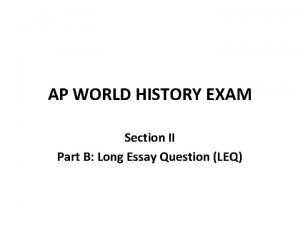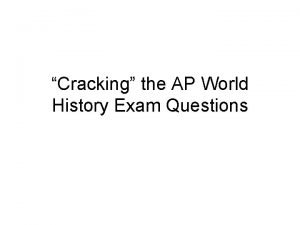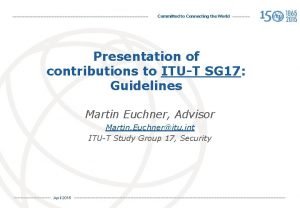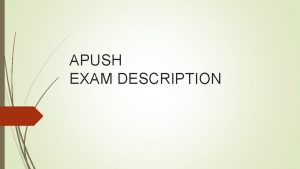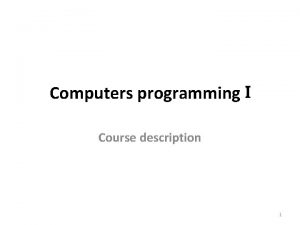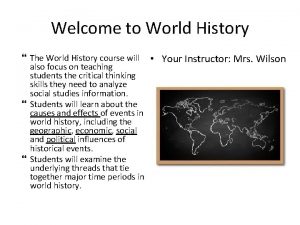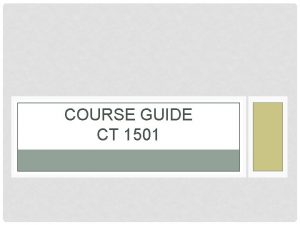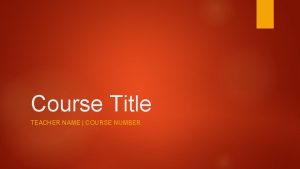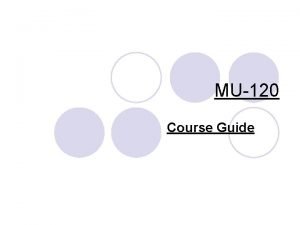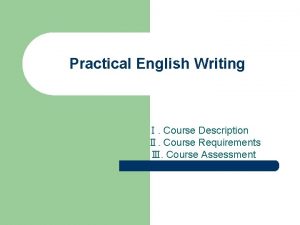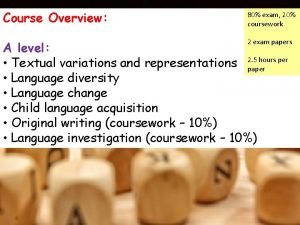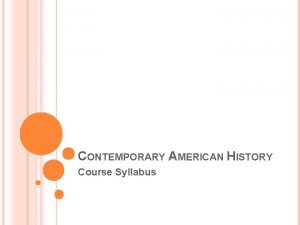AP World History Course and Exam Description Overview













- Slides: 13

AP® World History Course and Exam Description Overview

Overview of Framework Components § Structured around the investigation of: § Course themes § Disciplinary Practices § Historical reasoning skills § Six different chronological periods 2

Course Themes Theme 1 Interaction Between Humans and the Environment (ENV) Theme 2 Development and Interaction of Cultures (CUL) Theme 3 State-Building, Expansion, and Conflict (SB) Theme 4 Creation, Expansion, and Interaction of Economic Systems (Econ) Theme 5 Development and Transformation of Social Structures (Soc) 3

Disciplinary Practices Analyzing Historical Evidence & Argument Development Primary Sources § Describe historically relevant information and/or arguments within a source. § Explain how a source provides information about the broader historical setting within which it was created. § Explain how a source’s point of view, purpose, historical situation, and/or audience might affect a source’s meaning. § Explain the relative historical significance of a source’s point of view, purpose, historical situation, and/or audience. § Evaluate a source’s credibility and/or limitations. Secondary Sources § Describe the claim or argument of a secondary source, as well as the evidence used. § Describe a pattern or trend in quantitative data in non-text-based sources. § Explain how a historian’s claim or argument is supported with evidence. § Explain how a historian’s context influences the claim or argument. § Analyze patterns and trends in quantitative data in non-text-based sources. § Evaluate the effectiveness of a historical claim or argument. Argument Development § Make a historically defensible claim in the form of an evaluative thesis. § Support an argument using specific and relevant evidence. § Use historical reasoning to explain relationships among pieces of historical evidence. § Consider ways that diverse or alternative evidence could be used to qualify or modify an argument.

Historical Reasoning Skills Skill 1: Contextualization Describe an accurate historical context for a specific historical development or process. Explain how a relevant context influenced a specific historical development or process. Use context to explain the relative historical significance of a specific historical development or process. § Skill 2: Comparison Describe similarities and/or differences between different historical developments or processes. Explain relevant similarities and/or differences between specific historical developments and processes. Explain the relative historical significance of similarities and/or differences between different historical developments or processes. § Skill 3: Causation Describe causes or effects of a specific historical development or process. Explain the relationship between causes and effects of a specific historical development or process. Explain the difference between primary and secondary causes, and between short- and long-term effects. Explain the relative historical significance of different causes and/or effects § Skill 4: Continuity and Change Over Time Describe patterns of continuity and/or change over time. Explain the relative historical significance of specific historical developments in relation to a larger pattern of continuity and/or change. §

Historical Periodization for APWH Weighting Period 1: Technological and Environmental Transformations, to c. 600 B. C. E. 5% Period 2: Organization and Reorganization of Human Societies, c. 600 B. C. E. to c. 600 C. E. 15% Period 3: Regional and Transregional Interactions, c. 600 C. E. to c. 20% 1450 Period 4: Global Interactions, c. 1450 to c. 1750 20% Period 5: Industrialization and Global Integration, c. 1750 to c. 1900 20% Period 6: Accelerating Global Change and Realignments, c. 1900 to present 20%

AP® Course Audit Curricular Requirements § The College Board requires: – college-level reading material: textbooks, diverse primary sources and secondary sources, and work by scholars interpreting the past – opportunities for students to demonstrate command of course themes, historical thinking skills, and key concepts through activities and assignments – balanced global coverage, with Africa, the Americas, Asia, Oceania and Australia, and Europe represented with no more than 20% of course time devoted to European history (ex: more Mongols than Greece/Rome!) – content and skill coverage for exam preparation 7

The 2018 AP® World History Exam Format Section Question Type # of ? s Time % of total Score I Part A: Multiple-Choice 55 ? s 55 mins 40% I Part B: Short Answer 3? s 40 mins 20% Required #1 (Periods 3 -6) Required #2 (Periods 3 -6) Select #3 OR #4 (Periods 1 -3 & 4 -6) II Part A: DBQ 1? (Periods 3 -6) 60 mins (inc. 15 min reading period) II Part B: LEQ Select 1? /3 on AP themes (Periods 1 -2, 3 -4, & 5 -6) 40 mins 8 25% 15%

2018 APWH Exam Section Details: § Section I Part A: Stimulus-based Multiple Choice | 55 Questions | 55 Minutes | 40% of Exam Score § Questions appear in sets of 2 to 5. § Analyze historical texts, interpretations, and evidence. § Primary and secondary sources, images, graphs, and maps. § Section I Part B: Short Answer Questions| 3 Questions/4 (2 on periods 3 -6 & 1 on 1 -3 or 4 -6)| 40 Minutes | 20% of Exam Score § Students must explain the historical examples that they know best. § Some questions include texts, images, graphs, or maps. § Section II Part A: Document Based | 1 Question on periods 3 -6 | 60 Minutes (includes a 15 -minute reading period) 25% of Exam Score § Craft and defend a historical argument with evidence. § Analyze and synthesize historical data. § Assess written, quantitative, or visual materials as historical evidence. § Section II Part B: Long Essay | 1 Question/3 | 35 Minutes | 15% of Exam Score § Explain and analyze significant issues in world history. § Craft and defend a historical argument with evidence.

2018 APWH Exam § Thursday, May 17, 2018 § Morning exam time slot, 8: 00 § Bus is provided to/from SLC, but signed permission slip required

2014 -2017 Exam Results *Individual colleges and universities differ in their acceptance of AP exam scores. Most require at least a 3 on the AP exam. Many highly competitive colleges and universities honor only scores of 5. Some schools refuse any AP scores; they want to see you’ve taken AP, but expect you to take their program courses once enrolled.

The Ways of Thinking to Tackle APWH (~8, 000 BCE-the present… the whole world…no problem!) § Think about the Big Picture of world history. Consider the main § § § marker events, pivotal moments, or threshold moments from which things were never the same again Use & know Historical Reasoning Skills, Themes, Key Concepts, & Periodization Think comparatively (regions, civilizations, social classes, etc. ) Think about continuity & change over time Think about causation and causality Think about perspective, point of view, & factors of reliability Think about patterns & the overt exceptions

Support & Tactics § Your support team: teacher(s), librarians, counselor, family members, your in class study triad/quad, & APWH Consultants during SAS. § USE a planner. Organize your time & your APWH binder. Check the teacher website daily. § Do your reading. Class is NOT designed to reteach the text, but to bolster, expand use your learning from the text. § Use active reading strategies & effective note taking methods. § Know your learning style & use it to your advantage.
 Ap world course and exam description
Ap world course and exam description World history and geography final exam study guide
World history and geography final exam study guide World history spring final exam review answers
World history spring final exam review answers World history first semester exam review
World history first semester exam review World history final exam review
World history final exam review Ap world history leq
Ap world history leq Format of ap world history exam
Format of ap world history exam Us history semester 1 final exam study guide answers
Us history semester 1 final exam study guide answers Chemistry fall semester exam review answers
Chemistry fall semester exam review answers World history semester exam
World history semester exam Ap world history chapter 25 africa and the atlantic world
Ap world history chapter 25 africa and the atlantic world Dangerous world tour setlist
Dangerous world tour setlist Course number and title
Course number and title Overview of the world
Overview of the world





